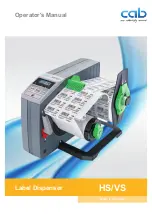
38
ENGLISH
I N S T R U C T I O N S F O R A U T H O R I Z E D I N S T A L L E R
Gas fired Boiler (optional)
Read the instructions before installing and using the appliance.
ATTENTION
This appliance can only be installed and used in permanently ventilated places according to UNI-CIG 7129 and UNI-CIG
7131 Standards.
Connection to gas supply
Position the appliance as described in the Use and Maintenance Manual, remove the grounds collecting tray with the grille and
connect the appliance to the gas supply mains, or LPG bottle (G30/G31), using rigid metal pipes or flexible metal tubes
according to UNI-CIG 9891 Standards.
Check that the appliance is prearranged for the type of gas actually being used; the corresponding setting is shown on the
settings tag.
If the appliance is prearranged for a different type of gas, change the arrangement as described in the paragraph "Changing the
calibration".
The gas infeed, consisting of an on-off valve (51), includes a G 1/8" threaded connection (thread is not gas-tight) according to
ISO 228-1 Standard.
If using rigid metal pipes for connection to the gas supply, place an appropriate fitting between the valve and the rigid metal
pipe, which should be provided with a G 1/8" female thread (thread is not gas-tight) according to ISO 228-1 Standard.
If using flexible metal tubes for connection to the gas supply, interpose an appropriate G 1/2" female nipple (gas-tight thread)
according to ISO 7-1 Standard and a G 1/2" male nipple (thread is not gas-tight) according to ISO 228-1 Standard; interpose a
suitable gas-tight gasket.
When the connection is completed, open the gas flow upstream of the appliance and, using a soapy solution (never a free
flame), check the perfect tightness of the connection.
Venting the combustion fumes
In relation to the venting of the combustion fumes, the appliance is of Type A1: i.e., it draws in the air required for combustion
from the room and discharges the fumes in the same environment.
Place particular attention to the volume of the room where the appliance is to be installed: this should be at least 12 m
3
.
If the room has a smaller volume, it will be necessary to install the appliance directly under a suction hood, and also to provide
a combustion air intake with a free-flow cross section of al least 100 cm
2
.
Ignition
Press and turn the gas valve knob (51) counterclockwise to the position of the flame symbol, as shown in Fig. B. While holding
the knob pressed, push a few times the burner ignition button, marked with the star symbol (53) to ignite the burner
(piezoelectric ignition).
When the flame is lit, check through the relative spyholes (54), while keeping the gas knob pressed for 5-10 seconds. After this
period, if the flame does not remain lit, repeat the ignition operation again.
Changing the calibration
The appliance is prearranged to operate with the gas indicated in the relative settings tag attached to the appliance. The
information regarding the air setting, injector, rated and reduced heat flow are shown in Tables 1 and 2. The data that
correspond with each model are indicated by the next-to-last character of the code for the relative model. For example, the
model code shown on the tag for the gas part characteristic 95-21-3 gr. shows number 3 in the next-to-last digit.
In this case, refer to the data shown in Tables 1 and 2, respectively, in the column headed "3 Units".
If you wish to change the calibration of the appliance, proceed as follows:
Unscrew the primary air adjusting ring nut (55 - Fig. C) to expose the nozzle (56). Using the relative wrench, unscrew the
nozzle (56) and replace it with the proper one indicated in Table 2, checking that the diameter marked on the same nozzle
corresponds to the right diameter.
Screw on the new nozzle (56), and position the primary air adjusting ring nut (55 - Fig. C) according to the indications of Table
1, using a gauge or equivalent instrument to set the distance "L", and tighten the screw provided to fasten the nozzle.
Turn the main switch (30) to position 1, so as to connect a single heating element (50% of the boiler's electric power for single-
phase heating element with 2 elements and 1/3 of power for heating elements with 3 elements with three-phase connection),
and ignite the burner as in the procedure described above. When the water contained in the boiler reaches the preset
temperature, the gas flow regulator will automatically decrease the flow to the value corresponding to the reduced rated heat
flow.
At this point, turn the flow regulation screw (58) so as to have a steady flame licking the sensitive thermocouple element (52),
and turn the screw (57) to obtain the maximum desired pressure value in the boiler.
Содержание 95 Series
Страница 6: ...CARATTERISTICHE DELLA MACCHINA 4 ITALIANO MOD AUTOMATICO MOD SEMIAUTOMATICO ...
Страница 7: ...SCHEMA IDRAULICO GENERALE 5 ITALIANO Versione a temperatura stabilizzata Versione normale ...
Страница 30: ...28 ...
Страница 34: ...MACHINE CHARACTERISTICS 32 AUTOMATIC MOD SEMIAUTOMATIC MOD ENGLISH ...
Страница 35: ...GENERAL HYDRAULIC DIAGRAM 33 ENGLISH Version with stabilized temperature Normal version ...
Страница 58: ...56 ...
Страница 62: ...FRANÇAIS 60 CARACTÉRISTIQUES DE LA MACHINE MOD AUTOMATIQUE MOD SEMI AUTOMATIQUE ...
Страница 63: ...FRANÇAIS 61 SCHÉMA HYDRAULIQUE GÉNÉRAL Version à température stabilisée Version normale ...
Страница 86: ...84 ...
Страница 90: ...88 DEUTSCH MERKMALE DER MASCHINE VOLLAUTOMATISCHES MOD HALBAUTOMATISCHES MOD ...
Страница 91: ...89 DEUTSCH ALLGEMEINER HYDRAULIKPLAN Normale Ausführung Ausführung mit stabilisierter Temperatur ...
Страница 114: ...112 ...
















































